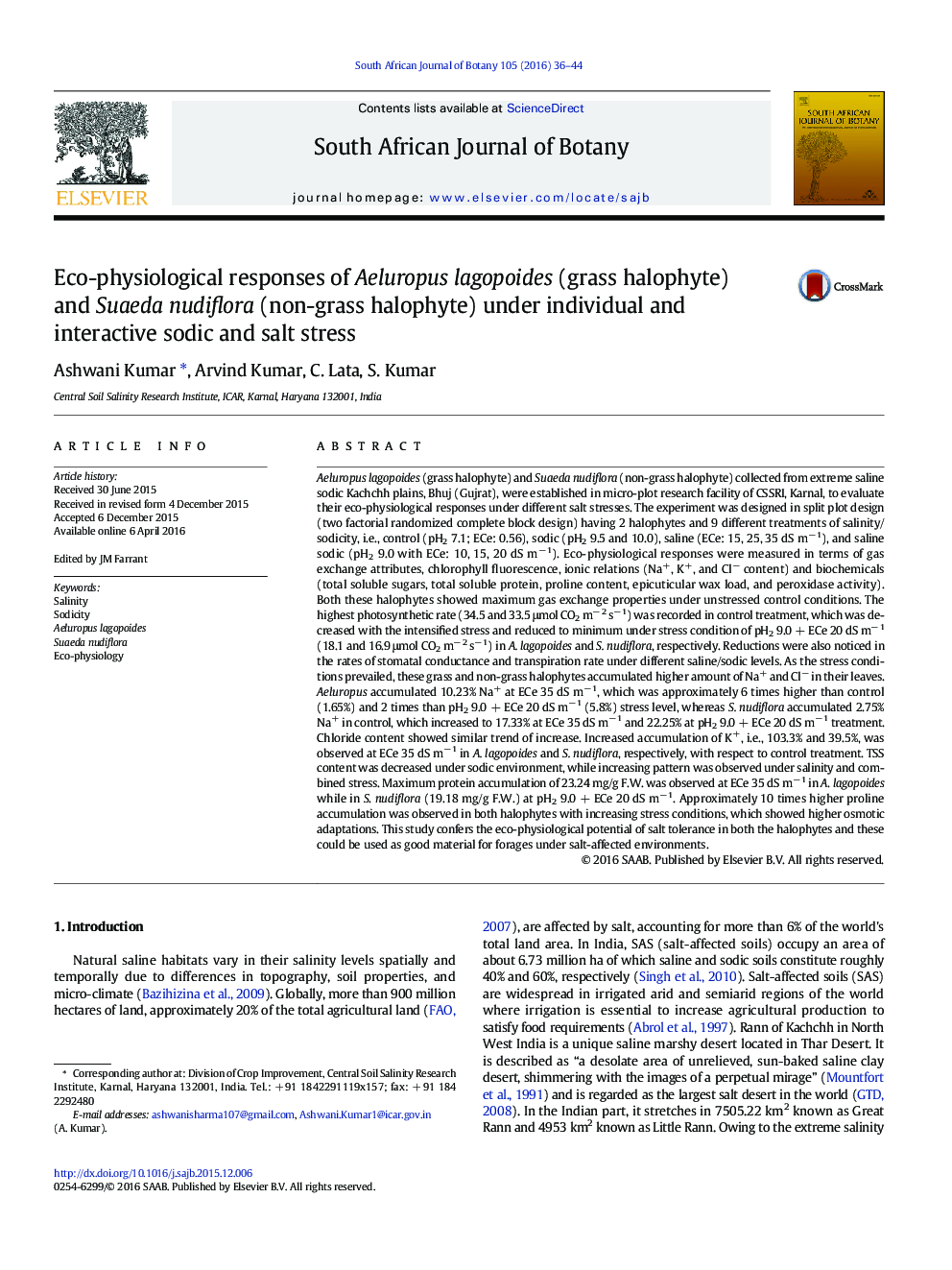| کد مقاله | کد نشریه | سال انتشار | مقاله انگلیسی | نسخه تمام متن |
|---|---|---|---|---|
| 4520100 | 1625153 | 2016 | 9 صفحه PDF | دانلود رایگان |

• Very few reports are available for this type of work, i.e., behavior of grass and non-grass halophytes under different salt stresses (salinity, sodicity, and mixed saline sodic stress) in the manuscript.
• Comparative physiological responses of grass and non-grass halophyte under 3 different stresses.
• Theses halophytes performs well under higher sodicity and salinity stresses, so we can use these halophytes for fodder under wasteland cultivation.
Aeluropus lagopoides (grass halophyte) and Suaeda nudiflora (non-grass halophyte) collected from extreme saline sodic Kachchh plains, Bhuj (Gujrat), were established in micro-plot research facility of CSSRI, Karnal, to evaluate their eco-physiological responses under different salt stresses. The experiment was designed in split plot design (two factorial randomized complete block design) having 2 halophytes and 9 different treatments of salinity/sodicity, i.e., control (pH2 7.1; ECe: 0.56), sodic (pH2 9.5 and 10.0), saline (ECe: 15, 25, 35 dS m− 1), and saline sodic (pH2 9.0 with ECe: 10, 15, 20 dS m− 1). Eco-physiological responses were measured in terms of gas exchange attributes, chlorophyll fluorescence, ionic relations (Na+, K+, and Cl− content) and biochemicals (total soluble sugars, total soluble protein, proline content, epicuticular wax load, and peroxidase activity). Both these halophytes showed maximum gas exchange properties under unstressed control conditions. The highest photosynthetic rate (34.5 and 33.5 μmol CO2 m− 2 s− 1) was recorded in control treatment, which was decreased with the intensified stress and reduced to minimum under stress condition of pH2 9.0 + ECe 20 dS m− 1 (18.1 and 16.9 μmol CO2 m− 2 s− 1) in A.lagopoides and S.nudiflora, respectively. Reductions were also noticed in the rates of stomatal conductance and transpiration rate under different saline/sodic levels. As the stress conditions prevailed, these grass and non-grass halophytes accumulated higher amount of Na+ and Cl− in their leaves. Aeluropus accumulated 10.23% Na+ at ECe 35 dS m− 1, which was approximately 6 times higher than control (1.65%) and 2 times than pH2 9.0 + ECe 20 dS m− 1 (5.8%) stress level, whereas S. nudiflora accumulated 2.75% Na+ in control, which increased to 17.33% at ECe 35 dS m− 1 and 22.25% at pH2 9.0 + ECe 20 dS m− 1 treatment. Chloride content showed similar trend of increase. Increased accumulation of K+, i.e., 103.3% and 39.5%, was observed at ECe 35 dS m− 1 in A. lagopoides and S. nudiflora, respectively, with respect to control treatment. TSS content was decreased under sodic environment, while increasing pattern was observed under salinity and combined stress. Maximum protein accumulation of 23.24 mg/g F.W. was observed at ECe 35 dS m− 1 in A. lagopoides while in S. nudiflora (19.18 mg/g F.W.) at pH2 9.0 + ECe 20 dS m− 1. Approximately 10 times higher proline accumulation was observed in both halophytes with increasing stress conditions, which showed higher osmotic adaptations. This study confers the eco-physiological potential of salt tolerance in both the halophytes and these could be used as good material for forages under salt-affected environments.
Journal: South African Journal of Botany - Volume 105, July 2016, Pages 36–44